Email remains one of the most reliable ways to reach your audience while generating $42 for every $1 spent. This means that it is an effective marketing strategy that every marketer should include in their toolkit.
With an email newsletter, you can easily keep your audience engaged and your business top of mind, but you can also use it to generate leads. However, there are several optimizations you need to implement to ensure your campaigns get the highest open rates, clicks, and conversions possible. These optimizations include the following:
Newsletter Optimizations:
- Optimize Your Subject Lines
- Groom Your List
- Include a Call-To-Action (CTA)
- Include Personalization
- Choose a Sender Name
- Avoid Dense Copy
- Segment Your Messages
- Include Social Sharing
- Optimize Your Email for Mobile Viewing
- Make Your Email Visually Interesting
- Include Preview Text
- Optimize Send Time
- Include an Unsubscribe Link
1. Optimize Your Subject Lines
Since it’s the first thing readers see before deciding whether or not to open your email, the subject line needs to catch their attention. Optimized subject lines will help you capture your audience’s attention and convince them to open your email to find out more.
The first step in optimizing your subject line is to ensure that it is relevant to your audience. You can do this by providing a value proposition relevant to them in the subject line, which encourages the reader to find out more about your offer and how it can solve their problem.
Personalizing your subject line is another way to optimize them. For example, if you’re targeting business owners, instead of using generic copy such as “Looking to boost your business’s online presence?” you could say, “Looking to boost Wishpond’s online presence?” to increase the chance of your email being opened.
Another tip is to make your subject line actionable using language that explicitly, clearly, and briefly states your offer without being overly persuasive.
Finally, to determine which strategies work best, always A/B test your email newsletters. This will allow you to iterate on your messaging to increase interest by sending multiple versions of your email. You can use A/B testing to try different subject line optimization strategies such as value propositions, personalization, and formatting.
With an email marketing tool such as Wishpond’s, you can easily A/B test all aspects of your email marketing campaigns, including subject line, sender name, and email address, as well as email content.

2. Groom Your List
While it would be great if everyone on your email list stayed engaged with your content, the reality is that the number of subscribers will decrease over time. That’s why it’s essential for you not to spend too much time thinking about the size of your email lists.
To ensure that your email lists are optimized for engagement, you need to regularly take a few steps to ensure that the quality of your email list remains high. These include:
- Removing subscribers that aren’t engaging
- Removing subscribers that aren’t relevant to your core business
- Removing auto-responders
A definite no-no is to rely on purchased lists. Since the audience didn’t opt into your marketing campaign, relying on such a list is likely to negatively impact your campaign at best or see it blocked at worst.
By grooming your email list, you’ll be less likely to land in your subscriber’s spam folder and increase your engagement rates.
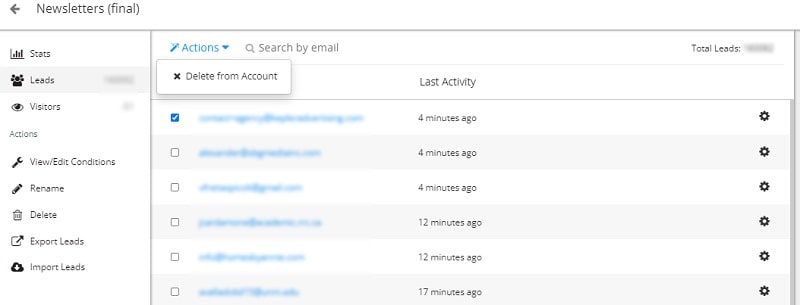
3. Include a Call-To-Action (CTA)
While there are many different ways to use email marketing, a common strategy is to use email newsletters to drive awareness. This is a great way to reach new audiences and increase brand visibility, but it often represents a missed opportunity at converting these audiences.
Just because you’re aiming to reach new audiences and drive brand awareness doesn’t mean you can’t also inform this audience about business and services and/or products.
Including strong calls to action in your email newsletter is a great way to drive an engaged audience to your website and build relationships.

4. Include Personalization
Studies have shown that 40% of email subscribers have marked emails as spam because they thought they were irrelevant, so ensure your email newsletter is relevant to your audience is key.
Addressing the reader by their name, or including information such as the company they work for, is a great way to increase the relevance of your email since it shows that you understand who the reader is, what kind of problems they may be facing, and how you can help solve them.
The more information you have about your subscribers, the more data you have available for personalization. If you have behavior or demographic data, you can include this rather than relying on addressing them by name.
Other data points you could include their location, their position, blog posts they’ve viewed on your website or even previously purchased items. It’s really up to you which data you collect and how to leverage it, but the important thing is to show the reader that they’re not part of a mass marketing campaign.
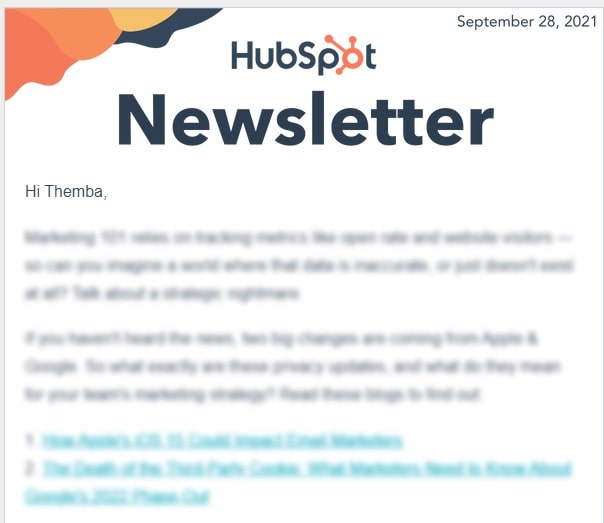
5. Choose a Sender Name
It’s important for you to build trust with your subscribers. Apart from the subject line, your email newsletter recipients see the sender’s name first. This means it is a deciding factor in whether or not they will open it.
Optimization of the sender’s name and using it consistently will help you to build a sense of trust with your subscribers and make future emails more recognizable.
As the above point showed, personalization is an important part of email marketing, and sending your newsletters from a real person is a simple optimization you can take to increase how personal your email marketing campaigns feel.
Another option is to include a small picture of yourself as part of your email signature. Not only does this give your emails a more personable look, but it also reinforces the fact that this mail is coming from an actual person and not a faceless digital marketing machine.
Don’t forget to test out different sender names to find out which works best for you and your business. While in some cases sending them from the CEO might make sense, in other cases, sending it from the head of sales or the author of the content might make more sense.
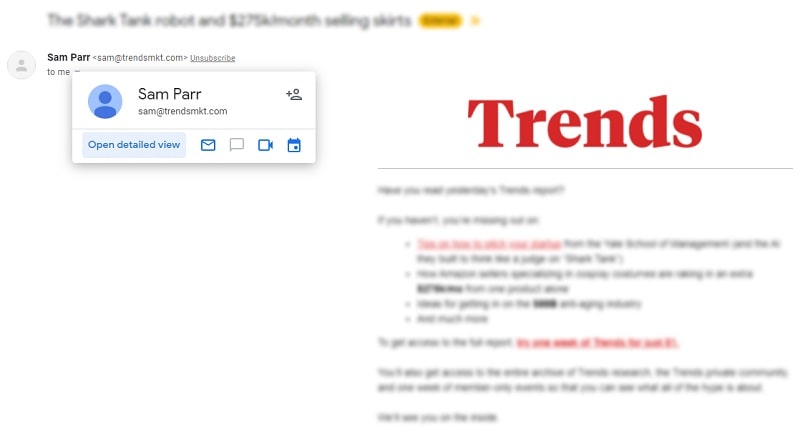
6. Avoid Dense Copy
Your emails should be engaging but to the point. If you optimize your email copy, you can increase the readers’ chances of being convinced by your offer and click-through to take advantage of it.
You need to clearly convey your offer and its value using brief but engaging language. You can do this by telling a compelling story, including statistics, great similes to spark imagination, and using bold language.
A final tip is to keep your sentences and paragraphs short and to break up your copy with bullet points. Emails with dense copy are likely to overwhelm readers, putting them off it.

7. Segment Your Messages
As mentioned above, personalization is key in digital marketing. Another great way of doing this in your email marketing campaigns is to deliver personalized content to your recipients through list segmentation.
By segmenting your list based on metrics such as prior behavior, demographics, or purchase history, you can create more relevant content for the recipients of your emails, increase the chance of conversion.

8. Include Social Sharing
You want your readers to share your content, and one way to encourage them to do so is to make it easy for them by including links to share via the social media platform of their choice.
If your audience shares your content, you not only reach new audiences in their network but also increase the chances of generating fresh leads since they won’t exist in your leads database yet, if they convert, unlike the recipients of your emails.
All your emails should include the option to share via social media. You should also give your readers a choice of platforms that, at a minimum, should include popular ones like Facebook, Twitter, LinkedIn, Pinterest, and Google+. You should also give your readers the option to forward the email in order to increase the chances of generating new leads.
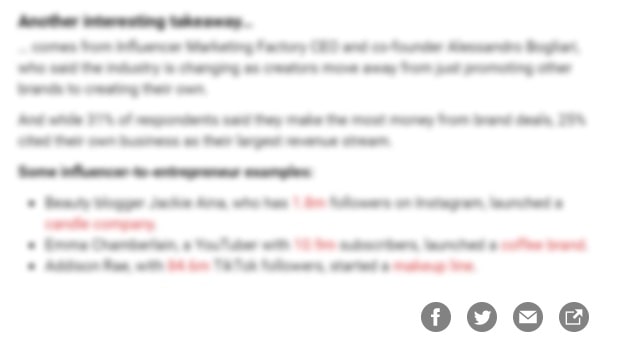
9. Optimize Your Email for Mobile Viewing
Statistics have shown that mobile accounted for 42% of all email opens in 2019. This means that if your emails aren’t optimized for mobile viewing, almost half of your readers won’t be able to read your content properly, resulting in a reduced engagement rate.
Using Wishpond’s email marketing tool, it’s easy for you to send emails optimized for mobile thanks to its extensive library of mobile-friendly templates, increasing the open rates and click-through rates of your emails on mobile.
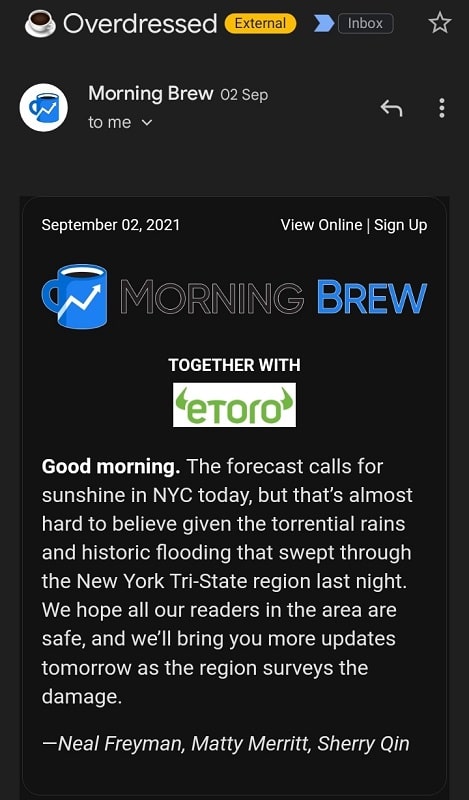
10. Make Your Email Visually Interesting
Although, in some cases, plain-text emails are the best option for your email marketing campaign, generally, it is a good idea to ensure that your emails are visually engaging.
Using images is a great way to grab your audience’s attention while also giving additional information about your offer. However, it’s important to use relevant images rather than relying on generic stock images that you found through a cursory search.
Be sure to keep image size as low as possible to reduce load times and include alt tags for users who have images disabled in their email clients.
Other options include using emojis in your email to break up the copy, make it feel more friendly and visually interesting, or embedding videos to increase engagement.
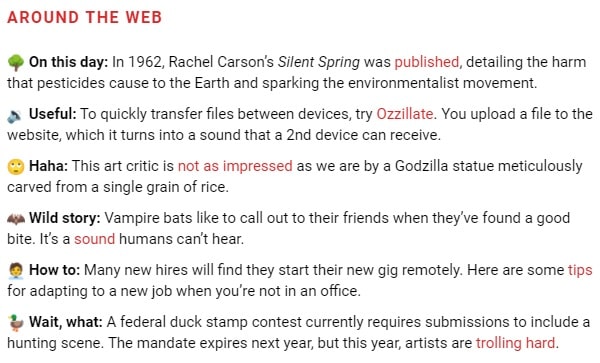
11. Include Preview Text
Preview text is the piece of text shown below or next to an email’s subject line in the inbox. Its purpose is to tell users more about what’s inside the email. Since most email clients support preview text, it’s a great way to connect with your subscribers further and give your subject line extra context.
Rather than letting the email client decide what to use as your preview text, which is usually the first few lines from the email, with the right email marketing tool, you can specify exactly what you want the preview text to look like.
Although similar and sometimes used interchangeably, there is a difference between preview text and preheader text. As the name suggests, the latter is what’s shown at the top of your email when it has been opened (in the header area) but will also display as preview text if none is specified. This means you can use hidden preheader text in place of preview text if your email marketing tool doesn’t support preview text.

12. Optimize Send Time
As the name suggests, send time optimization refers to ensuring that you send your email campaigns at the right time to ensure that you have the best possible open rate and click-through rate among recipients.
While you can attempt to figure out the best time to send your emails through guesswork, a more effective option is to A/B test send times to determine the optimal time.
Beyond that, if your list includes recipients from multiple time zones, then optimizing sending times based on the various locations will be even more effective.
Finally, some email marketing tools include machine learning technology that can determine the best send time on a personal level, ensuring that each recipient receives the email at a time when they are most likely to engage with it.
13. Include an Unsubscribe Link
Including an unsubscribe link in your email is important because it’s actually illegal not to do so!
But apart from complying with the law, including an unsubscribe link helps you ensure that only those who want to hear from you receive your emails, increasing your open rates and click-through rates.
Make it easy for people to find the unsubscribe link without making it overly prominent. You don’t want them to get annoyed trying to locate it and marking your email as spam; as a result, damaging your sender reputation.
Finally, humor in the unsubscribe link and page is an excellent way to try and get your readers to stay subscribed or at least engage with you via another platform. Provide them with compelling but funny reasons to stay, and they just might.

Related Content
- 8 Tips to Make Unsubscribe Pages Work for You
- 3 Critical Ways to Build Your Blog and Newsletter Audience
- Comparing The 21 Best Email Newsletter Tools
- 7 Best Newsletter Sign Up Examples
- How to Write a Newsletter Your Customers Want to Read
- 12 Tips: How to Use Email to Drive Traffic to Your Blog
Wrapping Up
There you have it – 13 ways to optimize your newsletter to increase your open rates, click-through rates, and conversions. While it may seem daunting, if you these steps, your email marketing campaigns will be given the best chance of success. Just remember to:
- Optimize Your Subject Lines
- Groom Your List
- Include a Call-To-Action (CTA)
- Include Personalization
- Choose a Sender Name
- Avoid Dense Copy
- Segment Your Messages
- Include Social Sharing
- Optimize Your Email for Mobile Viewing
- Make Your Email Visually Interesting
- Include Preview Text
- Optimize Send Time
- Include an Unsubscribe Link
What do you think of these tips? Have you used any of them before, and what were your results? Do you have any tips that I missed? Let me know in the comments below.

